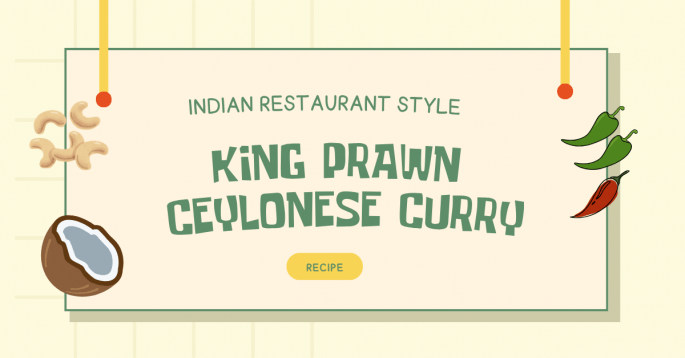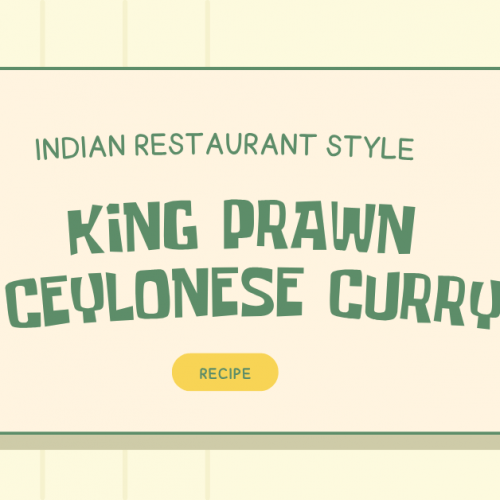Recreate a Scottish Indian takeaway style classic with this king prawn ceylonese curry recipe. A combination of chilli heat and creamy coconut, with a bright citrus finish.
If you’re looking to create an Indian takeaway style curry with a spicy and coconut rich sauce, this king prawn ceylonese recipe is for you. This Scottish Indian restaurant style recipe uses Indian restaurant style curry broth, as well as a combination of fresh and dried chillies, mango chutney, cashew butter and coconut flour. The resulting ceylonese curry sauce is spicy and full of rich coconut flavour.
Ingredients For King Prawn Ceylonese Curry
This Indian restaurant style king prawn ceylonese curry recipe is really easy to put together using Indian restaurant style curry broth. This pre-made broth is a spice and onion filled mix that you can use in a wide range of curry dishes. As in many Indian restaurant and takeaway kitchens, it serves as a building block to a variety of sauces and makes it possible to cook curry in just minutes. In this case, the broth is cooked out with other ingredients including green chillies, cashew butter and coconut to make a spicy and coconut packed curry sauce. With sizzling king prawns added to the simmering curry sauce, you can serve up this fiery Glasgow Indian takeaway style curry in just a few minutes!
- Green Chillies
- Sea Salt
- Vegetable Oil
- Dried Red Chilli
- Extra Hot Crushed Chillies
- Curry Broth
- Garlic Ginger Paste
- Tomato Puree
- Mild Red Chilli Powder
- Dried Fenugreek Leaves (Methi)
- Cooked King Prawns
- Fresh Coriander Leaves
- Tomato Ketchup
- Mango Chutney
- Ground Almonds
- Cashew Butter
- Coconut Flour
- Caster Sugar
- Creamed Coconut
- Fresh Lemon Juice or Lemon Dressing
How To Make King Prawn Ceylonese Curry
Making this spicy and coconut rich Scottish Indian restaurant style king prawn ceylonese curry is easy! And, with curry broth already prepared in the fridge or freezer, it takes just a few minutes too. First, green chillies are pounded to a paste. Then, a small amount of curry broth is added to a frying pan or curry pan with garlic ginger paste, tomato puree, chilli powder, dried fenugreek leaves and sea salt. More curry broth is added, along with cooked king prawns, mango chutney, cashew butter, coconut and lemon to create a hot coconut filled curry sauce. The finished sauce is citrusy and delicious, just like one you might expect to receive from your favourite Scottish Indian takeaway.
Step 1: Make Chilli Paste
In a pestle and mortar, add 2 fresh green finger chillies, thinly sliced and Pinch sea salt. Pound to a paste (be careful and look the other way to avoid any chilli cplashback!). Add 2 teaspoons vegetable oil, mix and set aside.
Step 2: Begin Curry
Heat 1 teaspoon vegetable oil in a frying pan or curry pan over a medium heat. Add 1 dried red chilli, cut into 2 pieces and 1/4 teaspoon extra hot crushed chillies and stir-fry for 20 seconds. Add 80 millilitres curry broth, 1 teaspoon garlic ginger paste, 1 teaspoon tomato puree, 1/4 teaspoon mild red chilli powder, 1 teaspoon dried fenugreek leaves (methi) and 1 small handful fresh coriander leaves, finely chopped. Mix well and simmer for 1-2 minutes.
Step 3: Simmer Curry
Add another 80 millilitres curry broth and simmer for another 2 minutes. Add 1 teaspoon mango chutney, 1 teaspoon ground almonds, 1 teaspoon cashew butter, 1 teaspoon coconut flour, 1 teaspoon caster sugar, 25 grams creamed coconut block and 100 millilitres water. Mix well and simmer for 3 minutes.
Step 4: Finish & Serve
Add 9 cooked king prawns and the remaining 80 millilitres curry broth, mix well and simmer for 2 minutes until the sauce is slightly thick and bubbling hot. Add 2 teaspoons fresh lemon juice or lemon dressing to finish, transfer king prawn ceylonese curry to a serving bowl and serve with your favourite Indian rice and breads.
Recipe Tips For Indian Restaurant Style King Prawn Ceylonese Curry
Vegetarian Alternative: Use tinned / cooked chickpeas or cubed paneer instead of cooked king prawns.
Cooking The Curry Sauce: Each time the curry broth is added, let it simmer well and caramelise in the pan. You’ll see the ceylonese curry sauce change colour slightly as it cooks. You can do this with even better results using a curry pan.
More Curry Sauce: If the ceylonese curry sauce becomes thick too quickly (or if you like more spicy ceylonese curry sauce to mop up with plain chapatis), you can add a few tablespoons of water while the ceylonese sauce is cooking.
I hope you’ll try this Indian takeaway style king prawn ceylonese recipe. If you do, let me know your thoughts by leaving a review or a comment!
King Prawn Ceylonese Curry (Indian Takeaway Style)
Equipment
- 1 Frying Pan or Curry Pan
Ingredients
- 2 fresh green finger chillies, thinly sliced
- Pinch sea salt
- 2 teaspoons vegetable oil
- 1 teaspoon vegetable oil
- 1 dried red chilli, cut into 2 pieces
- 1/4 teaspoon extra hot crushed chillies
- 80 millilitres curry broth (for the first stage)
- 1 teaspoon garlic ginger paste
- 1 teaspoon tomato puree
- 1/4 teaspoon mild red chilli powder
- 1 teaspoon dried fenugreek leaves (methi)
- 1 small handful fresh coriander leaves, finely chopped
- 80 millilitres curry broth (for the second stage)
- 1 teaspoon mango chutney
- 1 teaspoon ground almonds
- 1 teaspoon cashew butter
- 1 teaspoon coconut flour
- 1 teaspoon caster sugar
- 25 grams creamed coconut block
- 100 millilitres water
- 9 cooked king prawns
- 80 millilitres curry broth (for the third stage)
- 2 teaspoons fresh lemon juice or lemon dressing
Instructions
- In a pestle and mortar, add 2 fresh green finger chillies, thinly sliced and Pinch sea salt. Pound to a paste (be careful and look the other way to avoid any chilli splashback!). Add 2 teaspoons vegetable oil, mix and set aside.
- Heat 1 teaspoon vegetable oil in a frying pan or curry pan over a medium heat. Add 1 dried red chilli, cut into 2 pieces and 1/4 teaspoon extra hot crushed chillies and stir-fry for 20 seconds. Add 80 millilitres curry broth, 1 teaspoon garlic ginger paste, 1 teaspoon tomato puree, 1/4 teaspoon mild red chilli powder, 1 teaspoon dried fenugreek leaves (methi) and 1 small handful fresh coriander leaves, finely chopped. Mix well and simmer for 1-2 minutes.
- Add another 80 millilitres curry broth and simmer for another 2 minutes. Add 1 teaspoon mango chutney, 1 teaspoon ground almonds, 1 teaspoon cashew butter, 1 teaspoon coconut flour, 1 teaspoon caster sugar, 25 grams creamed coconut block and 100 millilitres water. Mix well and simmer for 3 minutes.
- Add 9 cooked king prawns and the remaining 80 millilitres curry broth, mix well and simmer for 2 minutes until the sauce is slightly thick and bubbling hot. Add 2 teaspoons fresh lemon juice or lemon dressing to finish, transfer king prawn ceylonese curry to a serving bowl and serve with your favourite Indian rice and breads.
King Prawn Ceylonese Curry Recipe FAQ
What is curry broth?
Restaurant and takeaway kitchens often use a prepared curry broth. It’s a rich onion and spice filled gravy that can be turned into jilander, korma, madras and most every other curry you can think of. You can use this recipe.
Can I use tandoori king prawns to make tandoori king prawn ceylonese curry instead?
You can definitely use cooked tandoori king prawns in this recipe to make a takeaway style tandoori king prawn ceylonese curry instead. It’s a great variation that will add a touch of char and smoke flavour to the finished curry sauce.
What can I serve with king prawn ceylonese curry?
This hot ceylonese curry is perfect with pilau rice and plain chapati.
Do you like this Indian takeaway style king prawn ceylonese curry recipe? If so, buying a copy of my book might appeal to you! In The Indian Takeaway Secret you can find a host of restaurant style recipes that you can make at home. You’ll learn how to make Glasgow style vegetable pakora, pink pakora sauce, South Indian garlic chilli chicken curry, pilau rice and more! You can buy The Indian Takeaway Secret in paperback or kindle form here.
- Make your favourite Indian takeaway dishes at homeKenny McGovern’s obsession with recreating takeaway and fast food dishes over the years has led him to the belief that Indian cooking is perhaps the greatest example that variety really is the spice of life
- The different herbs and spices used in Indian dishes creates a vast range and depth of flavour, from spicy, sweet, savoury and sour curry sauces to fragrant and aromatic sides
- The Indian Takeaway Secret is a meticulously researched love letter to Indian cooking, containing delicious examples of traditional Indian cooking and street-food style dishes alongside popular recipes honed and developed largely in the UK, as well as the fusion food offered in many Indian restaurants today
- Inside you will find restaurant classics like pakoras, bhajis, Dansak and Tikka Masala; classic dishes such as Sharabi and Tarka Dal; as well as street food favourites including Disco Fry Egg, Akoora and Aloo Subzi
- With this vast array of tasty takeaway recipes for every occasion, you’ll be able to enjoy all your favourite Indian food from the comfort of your own home – and at half the price!



